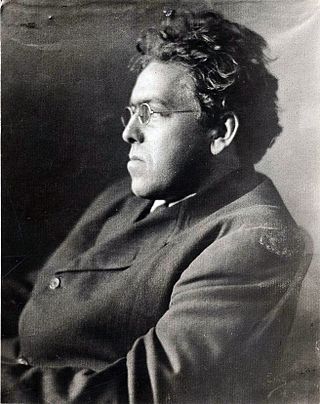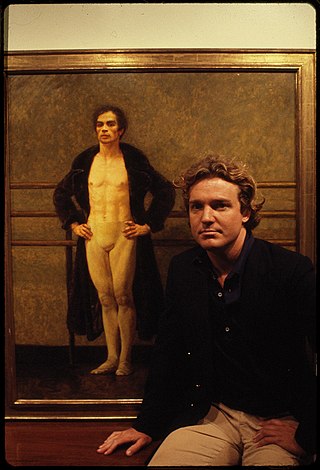
Thomas Edison State University (TESU) is a public university in Trenton, New Jersey. The university is one of New Jersey's 11 senior public institutions of higher education. Thomas Edison State University offers degrees at the undergraduate and graduate level.

Peter Hurd was an American painter whose work is strongly associated with the people and landscapes of San Patricio, New Mexico, where he lived from the 1930s. He is equally acclaimed for his portraits and his western landscapes.

Andrew Newell Wyeth was an American visual artist, primarily a realist painter, working predominantly in a regionalist style. He believed he was also an abstractionist, portraying subjects in a new, meaningful way. The son of N. C. Wyeth and father of Jamie Wyeth, he was one of the best-known U.S. artists of the middle 20th century. James H. Duff explores the art and lives of the three men in An American Vision: Three Generations of Wyeth Art. Raised with an appreciation of nature, Wyeth took walks that fired his imagination. Henry David Thoreau, Robert Frost, and King Vidor's The Big Parade (1925) inspired him intellectually and artistically. Wyeth featured in a documentary The Metaphor in which he discussed Vidor's influence on the creation of his works of art, like Winter 1946 and Portrait of Ralph Kline. Wyeth was also inspired by Winslow Homer and Renaissance artists.

Newell Convers Wyeth, known as N. C. Wyeth, was an American painter and illustrator. He was a student of Howard Pyle and became one of America's most well-known illustrators. Wyeth created more than 3,000 paintings and illustrated 112 books — 25 of them for Scribner's, the Scribner Classics, which is the body of work for which he is best known. The first of these, Treasure Island, was one of his masterpieces and the proceeds paid for his studio. Wyeth was a realist painter at a time when the camera and photography began to compete with his craft. Sometimes seen as melodramatic, his illustrations were designed to be understood quickly. Wyeth, who was both a painter and an illustrator, understood the difference, and said in 1908, "Painting and illustration cannot be mixed—one cannot merge from one into the other."

Brandywine Creek is a tributary of the Christina River in southeastern Pennsylvania and northern Delaware in the United States. The Lower Brandywine is 20.4 miles (32.8 km) long and is a designated Pennsylvania Scenic River with several tributary streams. The East Branch and West Branch of the creek originate within 2 miles (3 km) of each other on the slopes of Welsh Mountain in Honey Brook Township, Pennsylvania, about 20 miles (32 km) northwest of their confluence.

Chadds Ford Township is an affluent township in Delaware County, Pennsylvania, United States. It is located about 25 miles (40 km) southwest of Philadelphia.

James Browning Wyeth is an American realist painter, son of Andrew Wyeth, and grandson of N.C. Wyeth. He was raised in Chadds Ford Township, Pennsylvania, and is artistic heir to the Brandywine School tradition — painters who worked in the rural Brandywine River area of Delaware and Pennsylvania, portraying its people, animals, and landscape.

The Brandywine Museum of Art is a museum of regional and American art located on U.S. Route 1 in Chadds Ford, Pennsylvania on the banks of the Brandywine Creek. The museum showcases the work of Andrew Wyeth, a major American realist painter, and his family: his father N.C. Wyeth, illustrator of many children's classics; his sister Ann Wyeth McCoy, a composer and painter; and his son Jamie Wyeth, a contemporary American realist painter.

The Battle of the Assunpink Creek, also known as the Second Battle of Trenton, was a battle between American and British troops that took place in and around Trenton, New Jersey, on January 2, 1777, during the American Revolutionary War, and resulted in an American victory.

The Brandywine School was a style of illustration—as well as an artists colony in Wilmington, Delaware and in Chadds Ford, Pennsylvania, near the Brandywine River—both founded by artist Howard Pyle (1853–1911) at the end of the 19th century. The works produced there were widely published in adventure novels, magazines, and romances in the early 20th century. Pyle’s teachings would influence such notable illustrators as N.C. Wyeth, Maxfield Parrish, Harvey Dunn, and Norman Rockwell. Pyle himself would come to be known as the "Father of American Illustration." Many works related to the Brandywine School may be seen at the Brandywine River Museum of Art, in Chadds Ford.

The N. C. Wyeth House and Studio is a historic house museum and artist's studio on Murphy Road in Chadds Ford Township, Pennsylvania, United States. Beginning with its construction in 1911, it served as the principal home and studio of artist N.C. Wyeth (1882-1945). It was restored to its original appearance around the time of his death. The property is managed by the Brandywine River Museum, which offers tours. It was designated a National Historic Landmark District in 1997.

The French Arms Tavern was a structure in Trenton, New Jersey, that served as the capitol of the United States and meeting place of the Congress of the Confederation from November 1, 1784, to December 24, 1784. The building was located at the southwest corner of King and Second Streets from 1730 until 1837 when it was torn down.
John Willard McCoy (1910–1989) was an American artist who painted landscapes, portraits, and still lifes. He was married to the composer Ann Wyeth, the daughter of painter N.C. Wyeth and sister of painter Andrew Wyeth.
George Alexis Weymouth, better known as Frolic Weymouth, was an American artist, whip or stager, and conservationist. He served on the United States Commission of Fine Arts in the 1970s and was a member of the Du Pont family.
Carolyn Wyeth, daughter of N.C. Wyeth and sister of Andrew Wyeth, was a well-known artist in her own right. Her hometown was Chadds Ford, Pennsylvania. She worked and taught out of N. C. Wyeth House and Studio. Her nephew, Jamie Wyeth was one of her students.

The Kuerner Farm, also known as Ring Farm, is an historic farm which is located in Chadds Ford, Pennsylvania. It is notable for its association with artist Andrew Wyeth, who created about one-third of his work, more than 1,000 paintings and drawings, on subjects he found there during a span of seventy-seven years.

The Capture of the Hessians at Trenton, December 26, 1776 is the title of an oil painting by the American artist John Trumbull depicting the capture of the Hessian soldiers at the Battle of Trenton on the morning of Thursday, December 26, 1776, during the American Revolutionary War. The focus is on General George Washington aiding the mortally wounded Hessian Colonel Johann Gottlieb Rall. Nearly 900 Hessians were captured at the battle. It is one of Trumbull's series of historical paintings on the war, which also includes the Declaration of Independence and The Death of General Mercer at the Battle of Princeton, January 3, 1777. The painting is on view at the Yale University Art Gallery in New Haven, Connecticut.

George Washington's reception at Trenton was a celebration hosted by the Ladies of Trenton social club on April 21, 1789, in Trenton, New Jersey, as George Washington, then president-elect, journeyed from his home at Mount Vernon to his first inauguration in the then capital of the United States, New York City. A ceremonial triumphal arch was erected on the bridge over the Assunpink Creek to commemorate his two victories here, the Battle of Trenton on December 26, 1776 and the Battle of the Assunpink Creek on January 2, 1777.
James Trenchard (1747–?) was an American artist, printmaker, and engraver. He was born in Penns Neck, Salem County, New Jersey and by 1777 had moved to Philadelphia to work as an engraver. He was an illustrator for the Columbian Magazine and was its publisher from 1789 to 1790. In 1793 he emigrated to England.
American composer, pianist and painter Ann Wyeth McCoy was the youngest daughter of artist-illustrator N.C. Wyeth and the fourth of his five children. She was born in Chadds Ford, Pennsylvania. Ann had a life-long interest in antique porcelain dolls, which began in 1923 when she received her first doll as a gift from her parents on her eighth birthday. Each subsequent birthday and Christmas during her childhood, she received another doll. From 1972 to 2004 her doll collection was exhibited at the Brandywine River Museum in Chadds Ford during the Christmas holidays.

















